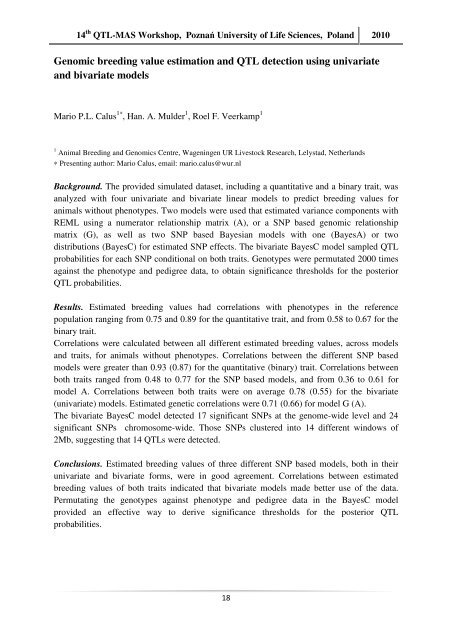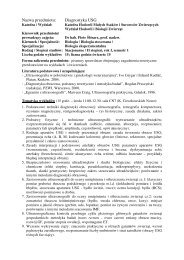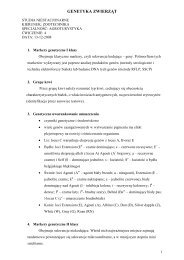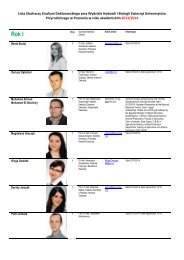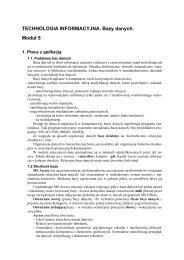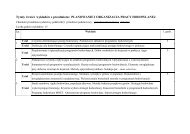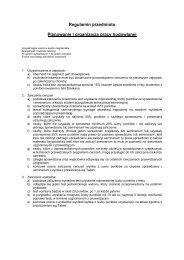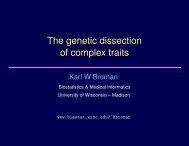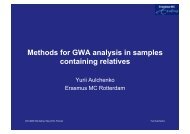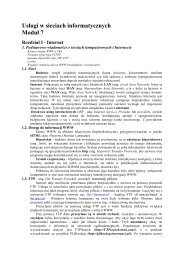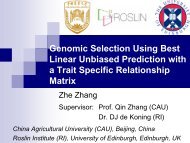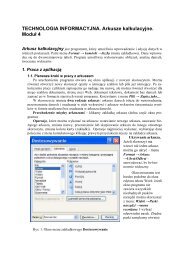The book of abstracts is available. - PoznaÅ
The book of abstracts is available. - PoznaÅ
The book of abstracts is available. - PoznaÅ
Create successful ePaper yourself
Turn your PDF publications into a flip-book with our unique Google optimized e-Paper software.
14 th QTL-MAS Workshop, Poznań University <strong>of</strong> Life Sciences, Poland 2010Genomic breeding value estimation and QTL detection using univariateand bivariate modelsMario P.L. Calus 1∗ , Han. A. Mulder 1 , Roel F. Veerkamp 11 Animal Breeding and Genomics Centre, Wageningen UR Livestock Research, Lelystad, Netherlands∗ Presenting author: Mario Calus, email: mario.calus@wur.nlBackground. <strong>The</strong> provided simulated dataset, including a quantitative and a binary trait, wasanalyzed with four univariate and bivariate linear models to predict breeding values foranimals without phenotypes. Two models were used that estimated variance components withREML using a numerator relationship matrix (A), or a SNP based genomic relationshipmatrix (G), as well as two SNP based Bayesian models with one (BayesA) or twod<strong>is</strong>tributions (BayesC) for estimated SNP effects. <strong>The</strong> bivariate BayesC model sampled QTLprobabilities for each SNP conditional on both traits. Genotypes were permutated 2000 timesagainst the phenotype and pedigree data, to obtain significance thresholds for the posteriorQTL probabilities.Results. Estimated breeding values had correlations with phenotypes in the referencepopulation ranging from 0.75 and 0.89 for the quantitative trait, and from 0.58 to 0.67 for thebinary trait.Correlations were calculated between all different estimated breeding values, across modelsand traits, for animals without phenotypes. Correlations between the different SNP basedmodels were greater than 0.93 (0.87) for the quantitative (binary) trait. Correlations betweenboth traits ranged from 0.48 to 0.77 for the SNP based models, and from 0.36 to 0.61 formodel A. Correlations between both traits were on average 0.78 (0.55) for the bivariate(univariate) models. Estimated genetic correlations were 0.71 (0.66) for model G (A).<strong>The</strong> bivariate BayesC model detected 17 significant SNPs at the genome-wide level and 24significant SNPs chromosome-wide. Those SNPs clustered into 14 different windows <strong>of</strong>2Mb, suggesting that 14 QTLs were detected.Conclusions. Estimated breeding values <strong>of</strong> three different SNP based models, both in theirunivariate and bivariate forms, were in good agreement. Correlations between estimatedbreeding values <strong>of</strong> both traits indicated that bivariate models made better use <strong>of</strong> the data.Permutating the genotypes against phenotype and pedigree data in the BayesC modelprovided an effective way to derive significance thresholds for the posterior QTLprobabilities.18


